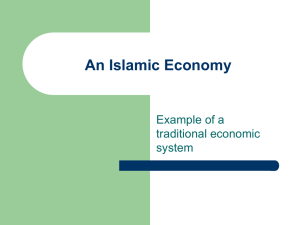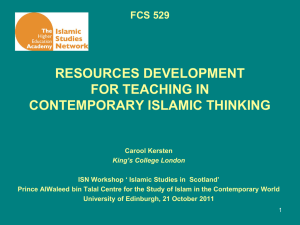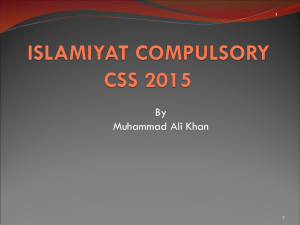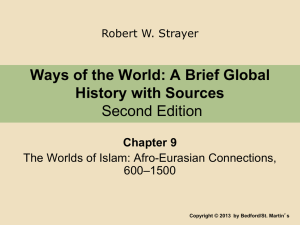COURSE INFORMATON
advertisement
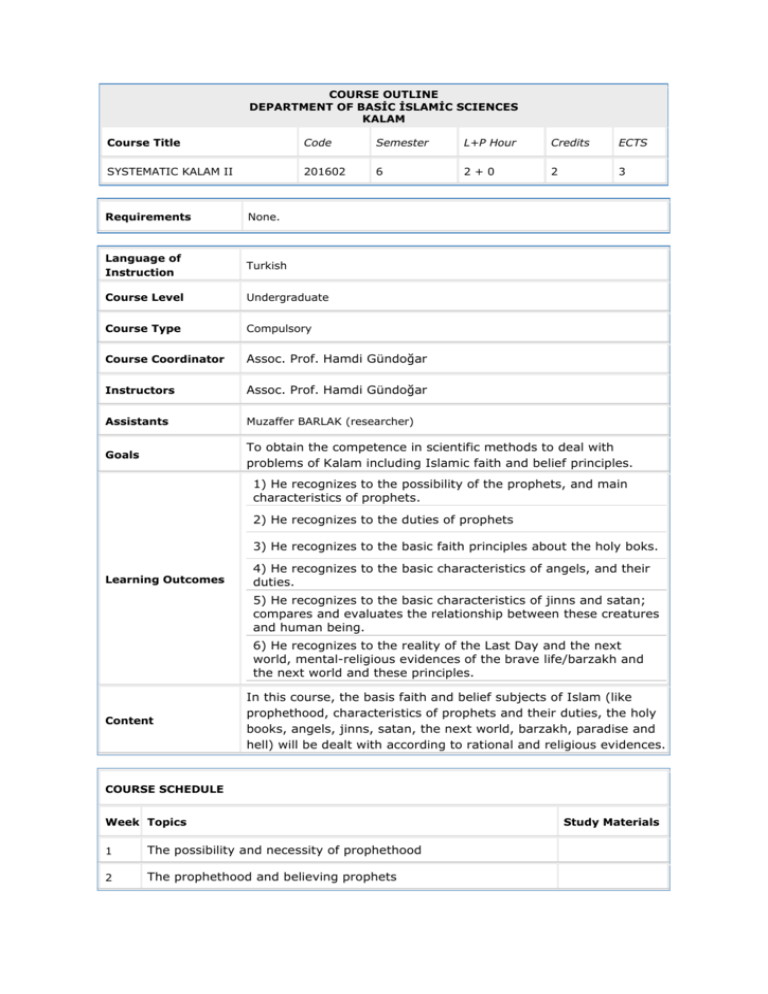
COURSE OUTLINE DEPARTMENT OF BASİC İSLAMİC SCIENCES KALAM Course Title Code Semester L+P Hour Credits ECTS SYSTEMATIC KALAM II 201602 6 2+0 2 3 Requirements None. Language of Instruction Turkish Course Level Undergraduate Course Type Compulsory Course Coordinator Assoc. Prof. Hamdi Gündoğar Instructors Assoc. Prof. Hamdi Gündoğar Assistants Muzaffer BARLAK (researcher) Goals To obtain the competence in scientific methods to deal with problems of Kalam including Islamic faith and belief principles. 1) He recognizes to the possibility of the prophets, and main characteristics of prophets. 2) He recognizes to the duties of prophets 3) He recognizes to the basic faith principles about the holy boks. Learning Outcomes 4) He recognizes to the basic characteristics of angels, and their duties. 5) He recognizes to the basic characteristics of jinns and satan; compares and evaluates the relationship between these creatures and human being. 6) He recognizes to the reality of the Last Day and the next world, mental-religious evidences of the brave life/barzakh and the next world and these principles. Content In this course, the basis faith and belief subjects of Islam (like prophethood, characteristics of prophets and their duties, the holy books, angels, jinns, satan, the next world, barzakh, paradise and hell) will be dealt with according to rational and religious evidences. COURSE SCHEDULE Week Topics 1 The possibility and necessity of prophethood 2 The prophethood and believing prophets Study Materials 3 The attributes and grades of prophets 4 The miracle and varieties of miracles 5 Believing the holy books; The Holy Quran and the other holy books and their peculiarities 6 Believing the angels, the peculiarities and kinds of them 7 Satan and jinn, the peculiarities and effects of these creatures 8 Believing the after here and proofs of the existence of the next world 9 The phases of the next world; the grave life/barzakh and characteristics of them. 10 The sings of the end of the world/Qiyamah; the big and little sings 11 The possibility and proving of the resurrection and importance of it 12 Resurrection, handing out the action books, and weighing human?s actions 13 Accounting- pair of scales; the bridge on the heaven/sirat; A´raf and ahl al-A´raf 14 The excistence, necessity and characteristics of Paradise and hell RESOURCES Main Resources A.Saim Kılavuz, İslam Akaid ve Kelama Giriş, Ensar Yay. , İst.,2004 Harikulade?, DİA, XVI, 181-188; ?Hatm-i nübüvvet? DİA, XVI, 477479; B. Topaloğlu, Y. Şevki Yavuz, İ. Çelebi, İslam?da İnanç Esasları, İstanbul 1991. 1- Reşid Rıza, Muhammedî Vahiy (trc. Salih Özer), Ankara 1991 2- Adil Bebek, Olağanüstü Olaylar ve Aralarındaki Farklar Mucize Keramet Sihir, İstanbul 1998. Additional Resources 3- H.İbrahim Bulut, Peygamber ve Mucize, Rağbet Yay. ,İst. 2001. 4- Emrullah Yüksel, Sistematik Kelam, İst. 2005. TDV İslam Ansiklopedisi ilgili maddeler. MATERIAL SHARING Documents Assignments Exams ASSESSMENT SYSTEM IN-TERM STUDIES QUANTITY PERCENTAGE Mid-terms 1 60 Quizzes 2 20 Assignment 1 20 Total 100 CONTRIBUTION OF IN-TERM STUDIES TO OVERALL GRADE 40 CONTRIBUTION OF FINAL EXAMINATION TO OVERALL GRADE 60 Total 100 Course Category (B) For the units in the exemption of the Faculty of Engineering Basic Vaciatonal Courses X CONTRIBUTION OF THE COURSE TO THE PROGRAM OUTCOMES No Program Learning Outcomes Contribution 1 2 3 4 5 1 The students can recite the Holy Qur’ān and translate it according to the rules appropriately. In addition to his own field of classic language, students be enabled to reach a level of 2 contemporary English yielding comprehension of the texts and be able to relate them orally and in writing. The students are to comprehend the words and the actions of the Prophet, recognize his Qurānic 3 attitudes, to know the course stages of the sayings of the Prophet, how the methods of the hadīth X did develop, the integrity of Qur’ān and hadith, and to know the position, the problems and various interpretations of hadīth in Islam. 4 5 6 7 The students learn about Islāmic jurisdiction from the classic and contemporary sources, within the X history of jurisdiction to be able to compare Islamic jurisdiction system with other systems. The students recognize Islāmic tenets in the lines of logical and narrational values, and be to comprehend the problems and the solutions of philosophy. The students be able to know the various classic and contemporary movements and their characteristics through the history of Islam. The students understand the different mystical thoughts, their orders, their leaders and ideas of ascetism and the history of mysticism in general. The students learn about the religious education within the history of education, to recognize the 8 classic and the modern education and can compare them, and comprehend the medium and the methodology of education with self confidence. 9 10 The students will develop a solid foundation through benefitting from learning philosophy, sociology and psychology and the data acquired from their field of science and from their methods. The students will learn about the contemporary religions and the religions existed in the past, their basic teachings and their characteristics. The students recognize the history and the stages Islamic civilization has being through, the inter- 11 relations of various civilizations, will be able to evaluate and analyze the synthetic methods of Islamic sciences and civilization and within the rules of criticism be able to know the strengths and X x weaknesses of them. The students will be able to learn about the Islamic literature through studying some well-known 12 examples, be acquainted with music, be able to perform some basic music, to recognize the difference of Islamic architecture and be able to compare it with others and be able to recognize the Islamic decoration art, its past and main works. ECTS ALLOCATED BASED ON STUDENT WORKLOAD BY THE COURSE DESCRIPTION Activities Quantity Total Duration Workload (Hour) (Hour) Course Duration 14 2 28 Hours for off-the-classroom study (Pre-study, practice) 14 2 28 Assignments 1 5 5 Presentation / Preparing Seminar 1 5 5 Mid-terms 1 10 10 Final examination 1 15 15 Total Work Load 32 39 91 Total Work Load / 30 (h) 3.03 ECTS Credit of the Course 3


